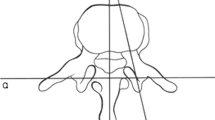Abstract
Purpose
The measurement of transverse pedicle width is still recommended for selecting a screw diameter despite being weakly correlated with the minimum pedicle diameter, except in the upper lumbar spine. The purpose of this study was to reveal the difference between the minimum pedicle diameter and conventional transverse or sagittal pedicle width in degenerative lumbar spines.
Methods
A total of 50 patients with degenerative lumbar disorders without spondylolysis or lumbar scoliosis of >10° who preoperatively underwent helical CT scans were included. The DICOM data of the scans were reconstructed by imaging software, and the transverse pedicle width (TPW), sagittal pedicle width (SPW), minimum pedicle diameter (MPD), and the cephalocaudal inclination of the pedicles were measured.
Results
The mean TPW/SPW/MPD values were 5.46/11.89/5.09 mm at L1, 5.76/10.44/5.39 mm at L2, 7.25/10.23/6.52 mm at L3, 9.01/9.36/6.83 mm at L4, and 12.86/8.95/7.36 mm at L5. There were significant differences between the TPW and MPD at L3, L4, and L5 (p < 0.01) and between the SPW and MPD at all levels (p < 0.01).
Conclusions
The MPD was significantly smaller than the TPW and SPW at L3, L4, and L5. The actual measurements of the TPW were not appropriate for use as a direct index for the optimal pedicle screw diameter at these levels. Surgeons should be careful in determining pedicle screw diameter based on plain CT scans especially in the lower lumbar spine.





Similar content being viewed by others
References
Bernard TN Jr, Seibert CE (1992) Pedicle diameter determined by computed tomography. Its relevance to pedicle screw fixation in the lumbar spine. Spine (Phila Pa 1976) 17:S160–S163
Chadha M, Balain B, Maini L, Dhaon BK (2003) Pedicle morphology of the lower thoracic, lumbar, and S1 vertebrae: an Indian perspective. Spine (Phila Pa 1976) 28:744–749
Krag MH, Weaver DL, Beynnon BD, Haugh LD (1988) Morphometry of the thoracic and lumbar spine related to transpedicular screw placement for surgical spinal fixation. Spine (Phila Pa 1976) 13:27–32
Misenhimer GR, Peek RD, Wiltse LL, Rothman SL, Widell EH Jr (1989) Anatomic analysis of pedicle cortical and cancellous diameter as related to screw size. Spine (Phila Pa 1976) 14:367–372
Li B, Jiang B, Fu Z, Zhang D, Wang T (2004) Accurate determination of isthmus of lumbar pedicle: a morphometric study using reformatted computed tomographic images. Spine (Phila Pa 1976) 29:2438–2444
Berry JL, Moran JM, Berg WS, Steffee AD (1987) A morphometric study of human lumbar and selected thoracic vertebrae. Spine (Phila Pa 1976) 12:362–367
Kim NH, Lee HM, Chung IH, Kim HJ, Kim SJ (1994) Morphometric study of the pedicles of thoracic and lumbar vertebrae in Koreans. Spine (Phila Pa 1976) 19:1390–1394
Mitra SR, Datir SP, Jadhav SO (2002) Morphometric study of the lumbar pedicle in the Indian population as related to pedicular screw fixation. Spine (Phila Pa 1976) 27:453–459
Nojiri K, Matsumoto M, Chiba K, Toyama Y (2005) Morphometric analysis of the thoracic and lumbar spine in Japanese on the use of pedicle screws. Surg Radiol Anat 27:123–128
Zindrick MR, Wiltse LL, Doornik A, Widell EH, Knight GW, Patwardhan AG, Thomas JC, Rothman SL, Fields BT (1987) Analysis of the morphometric characteristics of the thoracic and lumbar pedicles. Spine (Phila Pa 1976) 12:160–166
Cheung KM, Ruan D, Chan FL, Fang D (1994) Computed tomographic osteometry of Asian lumbar pedicles. Spine (Phila Pa 1976) 19:1495–1498
Nojiri K, Matsumoto M, Chiba K, Toyama Y, Momoshima S (2005) Comparative assessment of pedicle morphology of the lumbar spine in various degenerative diseases. Surg Radiol Anat 27:317–321
Senaran H, Yazici M, Karcaaltincaba M, Alanay A, Acaroğlu RE, Aksoy MC, Ariyürek M, Surat A (2002) Lumbar pedicle morphology in the immature spine: a three-dimensional study using spiral computed tomography. Spine (Phila Pa 1976) 27:2472–2476
Sugisaki K, An HS, Espinoza Orías AA, Rhim R, Andersson GB, Inoue N (2009) In vivo three-dimensional morphometric analysis of the lumbar pedicle isthmus. Spine 34:2599–2604
Brasiliense LB, Theodore N, Lazaro BC, Sayed ZA, Deniz FE, Sonntag VK, Crawford NR (2010) Quantitative analysis of misplaced pedicle screws in the thoracic spine: how much pullout strength is lost? Presented at the 2009 Joint Spine Section Meeting. J Neurosurg Spine 12:503–508
Conflict of interest
None.
Author information
Authors and Affiliations
Corresponding author
Rights and permissions
About this article
Cite this article
Makino, T., Kaito, T., Fujiwara, H. et al. Analysis of lumbar pedicle morphology in degenerative spines using multiplanar reconstruction computed tomography: what can be the reliable index for optimal pedicle screw diameter?. Eur Spine J 21, 1516–1521 (2012). https://doi.org/10.1007/s00586-012-2199-x
Received:
Revised:
Accepted:
Published:
Issue Date:
DOI: https://doi.org/10.1007/s00586-012-2199-x




